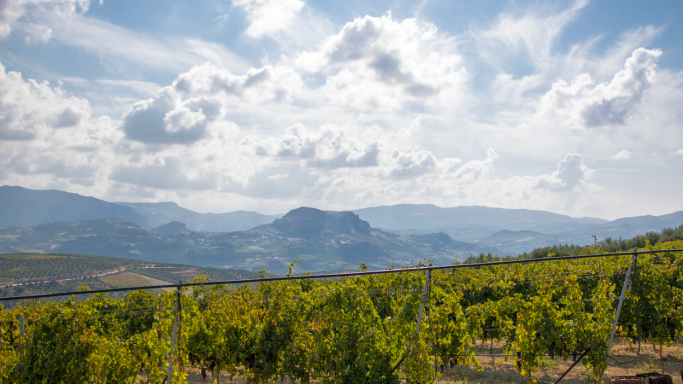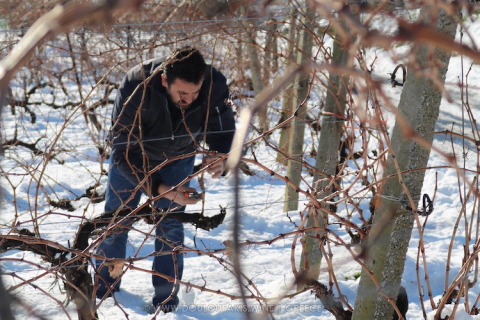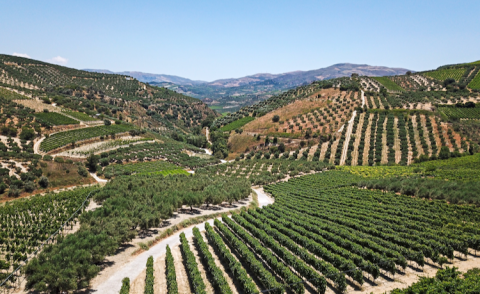From €8, $14.89, £14.20
A great-value and deliciously distinctive red from the Greek island of Crete.
Ever since the publication of Wine Grapes in 2012, I have found a much better way of getting to sleep than counting sheep: I go through the alphabet thinking of a different grape variety beginning with each letter. On particularly bad nights I have to go round more than once.
It seems I am stuck on Greek varieties beginning with L. After Limniona last month, now Liatiko. Next month, Limnio?
Not a rescued variety this time but an underrated one with a long history on the island (as recounted on the informative Douloufakis website). It suffered a slump in popularity in the second half of the 20th century. As third-generation winegrower Nikos Douloufakis explained in an email, ‘In the early 1960s and 1970s, Liatiko was the main red variety of Crete, producing wines for the local market. The arrival of phylloxera in the late 1970s and the trend among local winemakers towards international varieties have resulted in a decrease not only in Liatiko’s cultivation but also in its consumption. Everyone looked down on Liatiko in that period.’
Douloufakis swam against the current and planted new Liatiko vineyards in the early 1990s, believing in the potential of this variety for quality wine. Since the bottling of the first vintage of this wine in 1997, he has, he says, been ‘constantly exploring the limits of this extraordinary variety’, experimenting with different clones, different ways of cultivation such as raising the vine trunks to delay the harvest in order to be able to harvest riper grapes, and different styles of wine. The later ripening is important because the variety’s natural tendency is to accumulate sugar in the berries early (hence its name, derived from Iouliatiko, meaning ‘of July’) without being fully ripe in other respects.
Today it is 'back in the limelight', according to the company's agricultural technologist Natasa Stavroulaki, 'There is a clear upward trend. Everyone wants to plant it again.' Even so, Liatiko currently ranks only third among red varieties (11%), behind Kotsifali (42%) and Syrah (17%).
The Douloufakis Dafnios Liatiko 2019 shows all the hallmarks of this variety (no relation to the Italian red variety Aleatico): the colour is relatively light and more developed than you might expect for a wine of this age. It’s aromatic with red-fruit flavours that are both fresh and dried, attractively bitter-sweet. The fruit meshes perfectly with tannins, which here are perhaps a little firmer than is typical for this variety. The wine was aged in large oak casks for 12 months but is not at all oaky.
At the moment the tannins are just slightly leathery in texture, but the wine will age well in bottle and those tannins, which need food at the moment, will become increasingly silky, the wine’s flavours becoming more complex and perfumed. The alcohol is 13.5%.
It has been suggested that Liatiko has some similarity with Nebbiolo in its flavours and ageing trajectory, even if it can be a little more rustic. If so, Douloufakis’s training at Alba’s School of Oenology in Nebbiolo's home region of Piemonte might well have been propitious.
His own vineyards, 20 ha (50 acres) on limestone-rich hillsides at an elevation of 350–450 m (1,148–1,476 ft) in the Dafnes appellation, are certified organic but he does also buy in grapes from partner vineyards in the region. If you have time to spare, you might enjoy the Douloufakis YouTube video. The first half in particular zooms in on the location and gives great views of the vineyards and the topography, which might surprise those who associate Crete mostly with beach holidays.
Liatiko is versatile: Douloufakis also produces a Liatiko fermented in clay amphorae and an intense sweet wine called Helios, made from sun-dried grapes and aged 10 years in barriques. The current 2005 vintage is sweet, rich, persistent and yet so alive and fresh.
This dry red is widely distributed in Greece, the US (imported by Diamond Wine Importers) and the UK (imported by, and available from, Maltby & Greek) and also available in the Netherlands, Poland, Germany, Belgium, France , Denmark, Estonia, Czechia, Cyprus, Australia, Japan, Taiwan and Switzerland.
You'll find tasting notes on a wide range of Liatiko wines in our tasting notes database.




